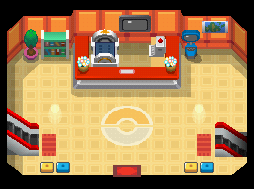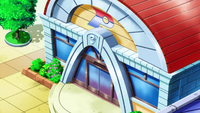Pokémon Center
- If you were looking for the retail store chain, see Pokémon Center (store).
A Pokémon Center (Japanese: ポケモンセンター Pokémon Center) is a type of building that provides regulatory services for Pokémon Trainers. Pokémon Centers are found in most towns and cities of the Pokémon world; every major city or town holds a Pokémon Center. Some Pokémon Centers can be found outside of towns next to large forests or caves. Pokémon Centers are built where many Trainers gather and the area becomes popular. This is to accommodate those Trainers in need and serve as a resting spot. The most common service the Pokémon Center offers is healing Pokémon free of charge.
In the games, Pokémon Centers consist of a healing station run by a nurse, a trading connection club, a battling connection club (neither of which require wires as of Generation III's Kanto remakes, although these do require apparatus to be attached to one's Game Boy Advance), various NPCs that vary upon location (in rural areas, no NPCs may be present) and, as of Generation V, salesmen from the Poké Mart due to its integration with the Pokémon Center in these games.
Fly brings the player to the Pokémon Center in the town or city chosen, and Teleport brings the player to the Pokémon Center they last visited (or to the Pokémon Center of the city or town they are currently in). Also, if defeated in battle, the player will appear at the Pokémon Center most recently visited (unless the player has not visited a Pokémon Center, in that case they will appear at their home).
In the games
In the Pokémon games, Pokémon Centers are important buildings found in most towns and cities, sometimes even on routes. Pokémon Centers are essential to Trainers as they provide many facilities and host most game mechanics. Non-player character Trainers and their own Pokémon are often found hanging around in Centers, offering general advice and information on the events in the town or area it is situated in. Though the setup of the Centers has varied slightly throughout each generation, all Pokémon Centers have these functions:
- A Pokémon Center Nurse heals all party Pokémon in a matter of seconds. This service heals all status conditions, recharges HP and PP of all party Pokémon, free of charge. The nurse is located at the main counter just as the player enters the Pokémon Center.
- Pokémon Centers also host the Cable Club and the Union Room, which facilitates multiplayer gameplay. Originally, linked players could only battle and trade one another, but in later generations, players can mix records and play games together.
- Trainers also have access to a PC so that they can change out their party. Players are able to deposit and withdraw Pokémon, along with ability to store and withdraw items and display their Hall of Fame details.
- In Generations I-III, saving the game inside a Pokémon Center is required to facilitate linking with console games such as Pokémon Stadium and Colosseum.
Generation I
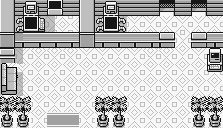
In Generation I, a Pokémon Center consisted of two counters on a single floor. The counter on the left has a nurse that will heal the player's Pokémon. The counter on the right contains the Cable Club, which allows players to link with each other. Talking to the women at the desk will allow the player to enter the Cable Club. Furthest to the right is the PC to deposit and withdraw Pokémon or items. Generation I also includes two of the few examples of a Pokémon Center that isn't in a town, which are the Pokémon Center on Route 4 outside Mt. Moon, and the Pokémon Center in Route 10 outside the entrance to the Rock Tunnel. Future generations employ rest houses that only offer healing services in areas similar to that.
Cable Club
The original link-up place was at the far end of the Pokémon Center in Generation I Kanto. Players can link together to simply battle each other in a one-on-one fight and trade Pokémon with each other. Two players linked by a first generation Link Cable can enter the cable club. Pokémon Yellow featured an extended version of the Cable Club with the option to choose special battle rules or cups.
Generation II
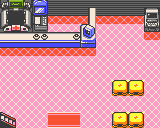
In Generation II, to accommodate greater linkup functionality, the Pokémon Centers of both Kanto and Johto expanded to two floors. On the first floor remained the counter where a nurse would heal Pokémon, as well as a PC, while on the second floor resided the Cable Club.
Cable Club
Located upstairs in Pokémon Centers throughout Johto and Kanto, this Cable Club consisted of three rooms. The Cable Club Trade Center facilitated trading, the Cable Club Colosseum allowed battling, and the Cable Club Time Capsule provided a way to trade Pokémon with the Generation I games. Because there were no female player characters prior to Kris's introduction in Pokémon Crystal, a player who has chosen Kris must be "changed" into the male player sprite before they may link with any other game. This is still the case if the game is linked with another copy of Crystal Version, even though sprite data for the female choice exists.
Two players can enter the Cable Club with a first generation Game Link Cable.
Pokémon Communication Center
Only in the Japanese Crystal version, there is the Pokémon Communication Center in Goldenrod City. Added was the ability to battle over mobile phones upstairs, and two new items downstairs: Pokémon News, a news machine which aggregated news about Trainer accomplishments and Trade Corner, which let a Trainer place a Pokémon up for trade. This process was in essence a prototype for the GTS, justifying the Global Terminal's placement in Pokémon HeartGold and SoulSilver.
Generation III
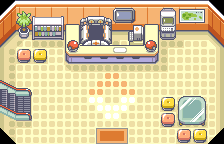
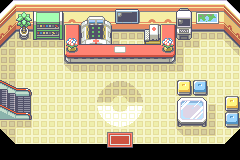

Pokémon Centers during Generation III remained in a two-floor setup, similar to the way they were in Generation II. The only difference is that the stairs to the second floor are larger and more noticeable, taking the shape of an escalator.
In Orre, there are only three official Pokémon Centers. They are located in Phenac City, Agate Village, and Gateon Port. The Agate Village and Gateon Port Centers do not have facilities for linking with the Generation III Game Boy Advance games and all have unique appearances, however. "Self serve" healing machines, identical to ones staffed by a nurse in a Pokémon Center, appear scattered throughout Orre, generally next to a PC.
Cable Club
Similar to the Cable Club in Johto, the Hoenn Cable Club's Pokémon Center has a Cable Club Colosseum and a Cable Club Trade Center. Now four players can link with a third generation Game Link Cable to battle in a Double Battle. A new feature was added to the Cable Club called the Cable Club Record Center, which allows two to four Trainers to swap data. Similar to the Pokémon News in Crystal version, swapped Trainer data shows up on television shows on televisions found all across Hoenn. Also, Trainers' secret bases are copied over in the record mixing.
Wireless Club
The Generation III Kanto and Emerald version Hoenn have a Wireless Club. The Wireless Club meets in the Union Room, where up to 40 Trainers may (in groups of five) talk and battle, as well as trade via a trading board similar to the Crystal version Trade Corner. The Cable Club's room has the standard Trade Center and Colosseum. Pokémon Emerald version's Cable Club also has the Record Center.
Generation IV
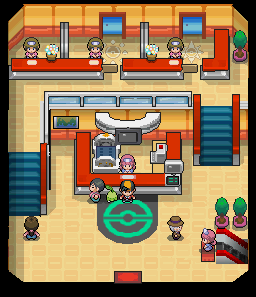
In Generation IV, Pokémon Centers introduce a basement floor, utilizing Nintendo Wi-Fi Connection. Opposite the second floor escalator, another escalator downstairs to the basement appears. While the second floor retains the same functionality that it did during Generation III with four player on the DS's wireless connection, the basement floor is where players can link up with others around the world using Nintendo Wi-Fi Connection. The first floor, as always, is where a player can heal their Pokémon and a PC. As of Pokémon Platinum players can also challenge a Trainer or Trainers inside some Pokémon Centers.
In Pokémon HeartGold and SoulSilver the Pokémon Center was redesigned again. The second floor became a mezzanine, located above and directly behind the main desk, and two staircases were added on each side of the desk for access to it. The PC was moved to the corner of the desk. All functions remain the same. The player's partner Pokémon will return to its Poké Ball while being healed. Also, if the first Pokémon in the player's party fainted prior to healing, it will return to being the partner as soon as it has been revived.
Wireless Club
In Generation IV, Sinnoh and Johto both have a wireless club just like Hoenn and Kanto, where players in a Union Room can battle, trade, mix records and, in Platinum, HeartGold and SoulSilver, spin Eggs. However, the Pokémon Centers in these regions also have a basement, where the Wi-Fi Club is located, for people to connect to each other if they are registered on each other's Pal Pad. Here they can battle and trade, and they can talk to each other through the built-in microphone of the DS, instead of with a chat box like it was in Generation III.
Wi-Fi Plaza
The Wi-Fi Plaza is an enhancement to the Wi-Fi Club in Pokémon Platinum, HeartGold and SoulSilver. It is found downstairs in the Pokémon Center. Players from around the world can enter a "plaza" to make Poffins and play mini-games together via Nintendo Wi-Fi. The player can walk around the plaza and communicate with other players in the plaza. A leap in multiplayer gameplay is introduced, allowing up to twenty players to enter the Wi-Fi Plaza at a time. The player may only spend a certain amount of time at the Wi-Fi Plaza each day.
Generation V
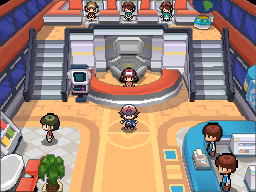
In Pokémon Black and White, the Poké Mart has been combined with the Pokémon Center, this is similar to how the Elite Four lobbies of previous generations contain both a Poké Mart and a Pokémon Center. The PCs in this generation have a help function, which describes a wide variety of game-related topics.
As with HeartGold and SoulSilver, the second floor is a mezzanine above the healing station. All wireless features found on the second floor Pokémon Centers in Generation IV, as well as the Wi-Fi feature present in basements, can be found here by talking to the person to the left and on the center, respectively. The person to the right allows players to access to Global Trade Station, as well as all the features brought by the Global Terminal, such as viewing of recorded videos. The Global Battle Union or GBU can also be accessed here, allowing players to battle random players via Wi-Fi. The Geonet globe can also be found on the second floor, allowing players to point out their real world location, as in the Generation IV games. All Pokémon Centers except the one in the Pokémon League have a second floor.
Differences among generations
- Pokémon Center RBGY.png
Generation I
- Pokémon Center BW.png
Generation V
Generation V (Victory Road)
In the anime
In the anime, a Nurse Joy heads each Pokémon Center. The healing process takes place in real time, unlike in the games, so Ash and his friends often have to wait until his Pokémon are fully healed. All Pokémon Centers are connected and, in times of crisis, all Pokémon can be transferred from one to another, as seen in Pokémon Emergency!. Pokémon Centers are considered an important service, as shown in Celebi and Joy where, in the past, the town residents built a Pokémon Center as a community project.

Pokémon Centers are designed for Trainers so they can rest between activities. Trainers use Centers as gathering places, so they can share information about Pokémon. They also have access to video phones, PC with trading functions and most offer free food and lodging. As a Pokémon journey can take a long time, Centers can be used as mailing destinations. A Trainer can arrange for their loved ones to send them packages, typically to the next Center they're traveling to. Inside a typical Pokémon Center, one can find a front desk, a lobby (sometimes with vending machines), a Poké Ball room, an Emergency Room with plenty of beds for injured Pokémon, a recovery room, a waiting room, rooms for lodging, and a cafeteria.
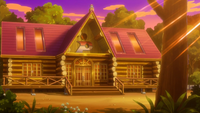
A lobby may also have a large widescreen TV or several smaller TVs so Trainers can watch typically Pokémon-oriented shows, such as Sinnoh Now, Pokémon Contest broadcasts, and major competitions like the Pokémon Leagues of each region and the Grand Festival. A typical sleeping room has a desk and chair and two sets of bunk beds to maximize space, and girls do not have to sleep in separate rooms from boys. At least one Center was shown in Uncrushing Defeat! to have a small library with a computer (presumably connected to some kind of internet), as an information room. It is unknown how these activities performed by a Pokémon Center are financed. On the outside, they come in all shapes and sizes, but usually have a rather large P somewhere.
In the TCG
The following is a list of cards named Pokémon Center.
| Pokémon Center Cards listed with a blue background are only legal to use in the current Expanded format. Cards listed with a green background are legal to use in both the current Standard and Expanded formats. | |||||||
|---|---|---|---|---|---|---|---|
| Card | Type | English Expansion |
Rarity | # | Japanese Expansion |
Rarity | # |
| Pokémon Center | T | Base Set | 85/102 | Expansion Pack | |||
| Nivi City Gym | |||||||
| Yamabuki City Gym | |||||||
| Base Set 2 | 114/130 | ||||||
| Wizards Black Star Promos | 40 | ||||||
| Pokémon Center | St | Next Destinies | 90/99 | Hail Blizzard | 051/052 | ||
Trivia
- For Dawn of a New Era!, Professor Oak's lecture is about Pokémon Centers. He writes this Pokémon senryū about it:「ジョーイさん あいたくなったら ポケモンセンター」"When I want to meet Nurse Joy, Pokémon Center."
- In Saving Darmanitan From the Bell!, Professor Oak's Live Caster is also about Pokémon Centers. He writes this Pokémon senryū about it:「ジョーイさん ポケモンセンター やすみなし」"Nurse Joy, Pokémon Center, without a break."
- If a Trainer gets at least four stars on their Trainer Card in Generation IV, the nurse at the Pokémon Center will make special mention of this, and then refer to the player by name upon subsequent visits.
- A man in the Resort Area describes how Pokémon Centers come to be in an area. When Pokémon appear, Trainers will also come. When Trainers appear, Pokémon Centers will also come about.
- The Pokémon Center's theme music has remained essentially the same throughout the franchise. It is notably different at night time in Generation IV.
- A remix of the theme music was used in Super Smash Bros. Brawl.
- In the Japanese and Korean versions of the Generation II games, the sign of Johto's Pokémon Centers have a Poké Ball logo and the letters PC while Kanto's use the same sign as Generation I. However, the Generation I sign was used for both regions in the international versions.
- In Pokémon HeartGold and SoulSilver, the nurse's speech line after healing the player's Pokémon was changed from "We hope to see you again!" to "Please, come back again any time!"
- However, after the player receives four Trainer stars, she says "We hope to see you again!" instead.
- Interestingly, the original speech line was changed back full-time in Pokémon Black and White, most likely due to the inclusions of the Poké Mart and GTS.
- In Generation IV, if the "walk through walls" cheat is used to go past the desk, and the cash register-like object is interacted with, the dialogue will be the same one used when interacting with the shelves in a Poké Mart.
- In the Sinnoh-based games, a healing machine can be obtained in the Underground to be placed in the Secret Base. However, it cannot heal Pokémon.
- If the player heals their party in a Gen V game when it is the player's stated birthday, then the nurse will say "Hey! Is today your birthday?". If the player replies Yes, then the nurse will say "Happy Birthday! Please keep visiting the Pokémon Center for many years to come. Now would you like to rest your Pokémon?" From there, the normal healing process will continue. If the player replies No, the nurse will say "It isn't? Oh I must have been confused." From there, the normal healing process will continue.
In other languages
| |||||||||||||||||||||||||||||||||||

|
This article is part of Project Locations, a Bulbapedia project that aims to write comprehensive articles on every location in the Pokémon world. |
